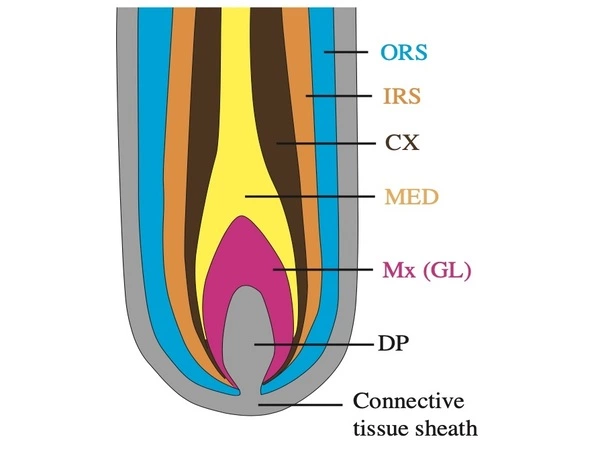Keratin is a protein produced by keratinocyte cells that moves to the skin and dies. While the follicles are active in the scalp, the bulb serves as the foundation for the hair root. The dead cells form strands that renew themselves as part of the life cycle. While the strands are dead, the follicles must be kept healthy in order for new hair to grow back after thinning or loss.
A single chemical is crucial in controlling when hair follicle cells divide and die. Because follicles contain stem cells, this discovery has the potential to not only treat baldness but also to accelerate wound healing.
Most cells in the human body have a fixed form and function that is determined during embryonic development. A blood cell, for example, cannot become a nerve cell or vice versa. Stem cells, on the other hand, are like the blank tiles in a game of Scrabble in that they can be transformed into other types of cells. Because of their adaptability, they can be used to repair damaged tissue or organs.
“In science fiction, when characters heal quickly from injuries, the idea is that stem cells enabled it,” said, a mathematical biologist at UC Riverside and study co-author.
TGF-beta has two opposite roles. It helps activate some hair follicle cells to produce new life, and later, it helps orchestrate apoptosis, the process of cell death. Even when a hair follicle kills itself, it never kills its stem cell reservoir. When the surviving stem cells receive the signal to regenerate, they divide, make new cell and develop into a new follicle.
Qixuan Wang
“In practice, our new research brings us closer to understanding stem cell behavior and promoting wound healing,” Wang said. This study is described in detail in a recent Biophysical Journal article.
In response to wounds, the liver and stomach regenerate. Wang’s team focused on hair follicles because they are the only organ in humans that regenerates automatically and on a regular basis, even when not injured.
TGF-beta, a type of protein, was discovered to control the process by which cells in hair follicles, including stem cells, divide and form new cells or orchestrate their own death, eventually leading to the death of the entire hair follicle.

“TGF-beta has two opposite roles. It helps activate some hair follicle cells to produce new life, and later, it helps orchestrate apoptosis, the process of cell death,” Wang said.
As with many chemicals, it is the amount that makes the difference. If the cell produces a certain quantity of TGF-beta, it activates cell division. Too much of it causes apoptosis. No one is entirely sure why follicles kill themselves. Some hypotheses suggest it is an inherited trait from animals shedding fur to survive hot summer temperatures or trying to camouflage.
“Even when a hair follicle kills itself, it never kills its stem cell reservoir. When the surviving stem cells receive the signal to regenerate, they divide, make new cell and develop into a new follicle,” Wang said.
Scientists may be able to activate follicle stem cells and stimulate hair growth if they can better understand how TGF-beta activates cell division and communicates with other important genes. Because many animals, including humans, have hair-covered skin, perfect wound healing would necessitate the regeneration of hair follicles. The ability to precisely control TGF-beta levels may one day lead to the cure of baldness, which affects millions of people worldwide.
“Our work has the potential to help people suffering from a variety of problems,” Wang said.
















